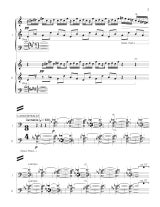- Compositions
- >
- Piano Duo/Duet
- >
- Diptychos for two pianos
Diptychos for two pianos
SKU:
$12.99
$12.99
Unavailable
per item
SOFTCOVER
2022
7 minutes
15 pages
in memoriam George Crumb
Listen
George Crumb (1929-2022) left a lasting impression on most of us composers, even those like myself, who met him just briefly. I had the good fortune to study with him both as a composer and as a pianist playing his work. Our first meeting was in Cape Town, South Africa, where he travelled with his wife in the late 1990s. I had the gall to present my Astroludes (12 preludes for piano on signs of the zodiac) in the composition masterclass. After hearing my performance of the work, he smiled with obvious pleasure, making one or two encouraging comments, and then, in such a sweet innocent way: "You know, I wrote a zodiac piece myself."
A few years later I met Crumb again, this time in the other Hemisphere, during his residency at Kent State University in Ohio, working with the Miro Quartet on their upcoming recording of Black Angels. A group of us tagged Music for a Summer Evening onto the festivities, received coaching from Crumb, and played it in an all-Crumb concert. I was amazed by him demonstrating his method of playing piano harmonics, by lifting the right hand high into the air and allowing the sonority to resonate. In both my meetings with Crumb I found him to be kind and modest, almost unbelievably unassuming for such a famous person. Since then I have always thought that if George Crumb has so little ego, no other composer should have too much.
In 2013 I was asked by Bayerische Rundfunk to present a themed concert that would explore a variety of styles in a cutting-edge way. I wanted to revisit Music for a Summer Evening, and had the idea to mix parts of that piece with other works of Crumb, and music of totally contrasting styles, in free association. The result was the stream-of-consciousness driven "Crumb Kaleidoscope," bringing together music of Bach, Chopin, chinese opera, jazz, and film, all intertwined with George Crumb. I don't know what he might have thought of it, but for me it was a deeply spiritual and engrossing experience of revisiting Crumb's work and reimagining it in other contexts.
Diptychos has two movements: a theme and one variation. The variation has the same structure as the theme, but doesn't develop it any further. It simply restates the material in a slightly different way, as a painter might do when creating a pair of artworks of the same subject from different perspectives. I used none of the inside-the-piano effects that Crumb is so famous for, but the work is clearly influenced by his focus on sonority, and the appearance of the score owes much to his meticulous calligraphy. The titles of the movements are taken from his zodiac piece, Makrokosmos II.






